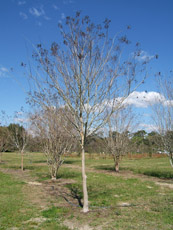Lagerstroemia spp. (Crapemyrtle)

*Click on picture for more images of this species.
- USDA Hardiness Zone: 7A - 9A
- Mature Height: 10 to 35 ft. depending on cultivar
- Mature Spread: 15 to 40 ft. depending on cultivar
- Growth Rate: Moderate
- Availability: Available
- Drought Tolerance: High
- Salt Tolerance: Moderate
- Light Requirements: Full sun
- Native Origin: Not native to North America. Invasive potential has not been assessed.
- Soil Drainage: Needs a well-drained site.
- Foliage: Deciduous tree with showy fall color.
- Flowers: White, pink, lavender or red, very showy flowers in the spring and summer.
- Pests: Free of serious pests and diseases, but aphids, powdery mildew and leaf spots can be a problem.
Description: A long period (May through September) of striking summer flower color, attractive fall foliage for some cultivars in some locations in some years, and good drought- tolerance all combine to make Crapemyrtle a favorite small tree for either formal or informal landscapes. It is highly recommended for planting in urban and suburban areas. Available in all shades of white, pink, red, or lavender, the 6- to 12- inch-long clustered blooms appear on the tips of branches during late spring and summer. The individual flowers are ruffled and crinkly as to appear made of crepe paper. The smooth, peeling bark and multi-branched, open habit of Crape-Myrtle make it ideal for specimen planting where its bright red to orange-colored fall leaves add further interest.
Most forms of the tree are upright, upright-spreading, or vase-shaped, spreading out as they ascend. Most tree types grow to 20 to 25 feet tall although there are dwarf types available. The upright, vase-shaped crown makes the tall-growing selections well-suited for street tree planting.
Pruning should be done in late winter or early in the spring before growth begins because it is easier to see which branches to prune. New growth can be pinched during the growing season to increase branching and flower number. Pruning methods vary from topping to cutting Crapemyrtle nearly to the ground each spring to the removal of dead wood and old flower stalks only. Topping creates several long, thin branches from each cut which droop down under the weight of the flowers. This practice disfigures the nice trunk and branch structure. Lower branches are often thinned to show off the trunk form and color. You can remove the spent flower heads to encourage a second flush of flowers and to prevent formation of the brown fruits. Since cultivars are now available in a wide range of growth heights, severe pruning should not be necessary to control size. Severe pruning or topping can stimulate basal sprouting which can become a constant nuisance, requiring regular removal. Some trees sprout from the base of the trunk and roots even without severe heading. This can be a maintenance nuisance.
Crapemyrtle grows best in full sun with rich, moist soil but will tolerate less hospitable positions in the landscape just as well, once it becomes established. It grows well in limited soil spaces in urban areas such as along boulevards, in parking lots, and in small pavement cutouts if provided with some irrigation until well established. It tolerates clay and alkaline soil well. However, the flowers of some selections may stain car paint.
Gainesville Observations: Trees have grown exceptionally well at our site in Gainesville. Some cultivars can be pruned into a central trunk like you would prune an oak tree. Most cultivars pruned in a variety of manners should be suited for planting near and under power lines. Most nurseries prune crapes into a standard with many branches growing from on top of a 5 to 7 foot tall single trunk. We have pruned using pollarding, topping, and light tipping (removing half of the previous year's twig growth) and compared this to not pruning at all and found that topping stimulates sprouting from the roots and from the trunk. Light pruning keeps trees looking sharp and does not stimulate sprouting.

